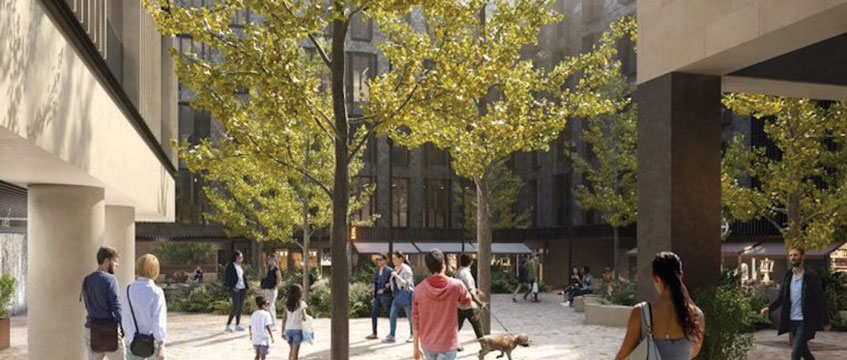Getting mixed-use down to a science in Oxford
A £200m-plus redevelopment of an Oxford shopping mall is giving its owner the chance to redefine what a mixed-use scheme can bring to a city centre.
Lothbury Investment Management has been given the go-ahead for a radical revamp of the Clarendon Centre, a 1980s shopping site with offices above. The centre has suffered from a shifting retail market and local competition since the 2017 reopening of Landsec and the Crown Estate’s larger Westgate Oxford.
The new proposals, approved unanimously by the city’s planning committee last week, will see the building partially demolished and rebuilt as a 226,547 sq ft scheme comprising not only retail space, restaurants and offices, but also research and development laboratories and student accommodation with a new public square.
A £200m-plus redevelopment of an Oxford shopping mall is giving its owner the chance to redefine what a mixed-use scheme can bring to a city centre.
Lothbury Investment Management has been given the go-ahead for a radical revamp of the Clarendon Centre, a 1980s shopping site with offices above. The centre has suffered from a shifting retail market and local competition since the 2017 reopening of Landsec and the Crown Estate’s larger Westgate Oxford.
The new proposals, approved unanimously by the city’s planning committee last week, will see the building partially demolished and rebuilt as a 226,547 sq ft scheme comprising not only retail space, restaurants and offices, but also research and development laboratories and student accommodation with a new public square.
For Adam Smith, executive director at Lothbury Investment Management, the project marks one of the most ambitious repositioning attempts the company has undertaken. “It’s not like a lot of these schemes which are just having a large proportion turned over to residential apartments,” he tells EG. “We could have done that. We looked at that. But we thought we could do something a little bit better than that.”
Three phases
Lothbury is already onsite at North Bailey House, a separate but neighbouring office scheme with ground floor retail and restaurants to the rear of the Clarendon Centre, consented in November and expected to complete in early 2023.
The first phase of the Clarendon Centre redevelopment is likely to begin this August and wrap up in November 2024, comprising the lab space and retail. Phase two will include 101 student beds, 35,000 sq ft of offices and ground floor retail and cafés. Smith hopes that can begin in mid-2023, so that the work around the new square and public realm overlaps with that of phase one. The final phase, which should span early 2025 until late 2027, will feature 68,000 sq ft of office space plus retail and café space.
Across the three phases, Smith and colleagues have aimed to zero in on the city’s individual areas of occupier demand. “In Oxford, you’re lucky enough to have a depth of demand from numerous sectors,” Smith says. “Labs was a nice one to key in on. We identified that a few years ago, and life sciences has gone from strength to strength – through Covid, in particular. We reduced the offices and brought in some student accommodation – again, you’re very lucky in Oxford to have a pool of people to prelet to.”
Rethinking space
The student accommodation is likely to be taken by the nearby Brasenose College, although the final paperwork is yet to get over the line, Smith said. In terms of the labs, he expects demand to come from “larger, more established users”, but much of the space will be start-up space for younger companies. Lothbury has struck a joint venture with Oxford Centre Enterprises, the University of Oxford’s investment partner, to set up 30,000 sq ft of incubator space for start-ups coming out of the university.
“There’s no one doing this in the city centre at the moment,” Smith says. “What we’re targeting is people coming out of the university who are used to working in the university labs with their professors on hand. We’re providing a private facility for them, for their new start-up companies, so that they still have that proximity to the university, to the infrastructure and the professors they are working with closely.”
Lothbury – in one guise or another – has overseen the property since it was built in the early 1980s. In recent years, the outlook for the centre as a retail-led asset became increasingly tough – and was ultimately “unsustainable”, as the company put it in planning documents related to the new proposals. Despite popular names such as TK Maxx taking space, other tenants left for Westgate, including anchor Zara.
With the pandemic only adding more pressure to the retail market, it was time for Lothbury to rethink what the almost 40-year-old centre should aspire to bring the city – and it wasn’t shops.
“Oxford’s got a lot of shopping. I don’t know if it’s quite a big enough city to sustain two shopping centres, particularly one with a 1,000-space car park,” Smith says. “This was a good opportunity for us to take another look at Clarendon.”
See more data about lettings in Oxford here
To send feedback, e-mail tim.burke@eg.co.uk or tweet @_tim_burke or @EGPropertyNews
Image from Lothbury Investment Management/Four











